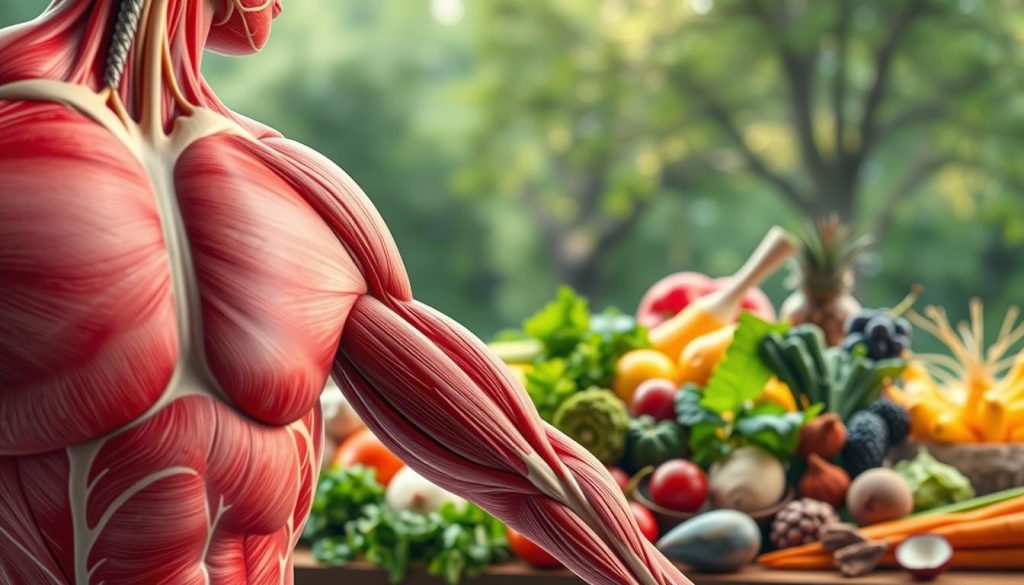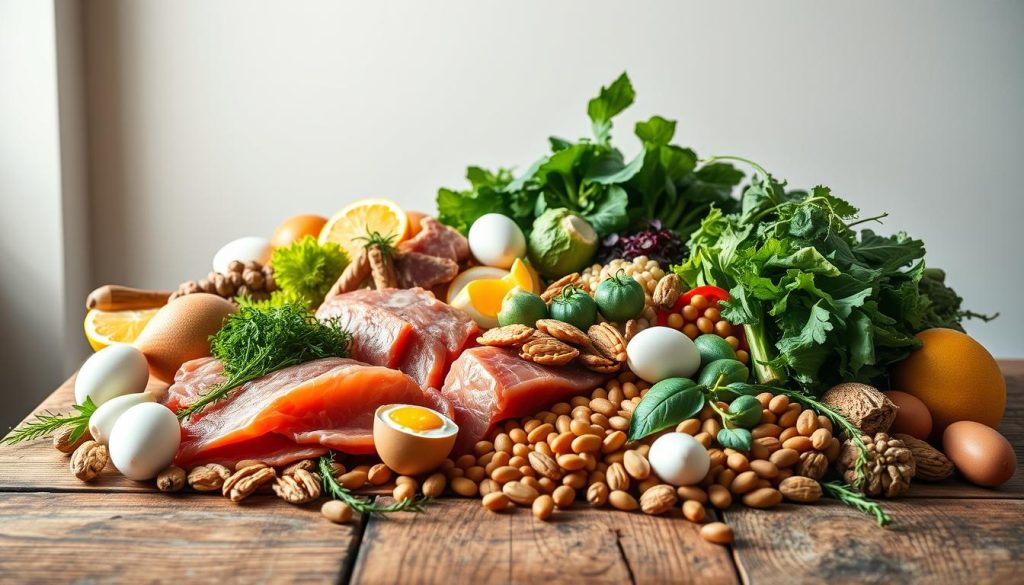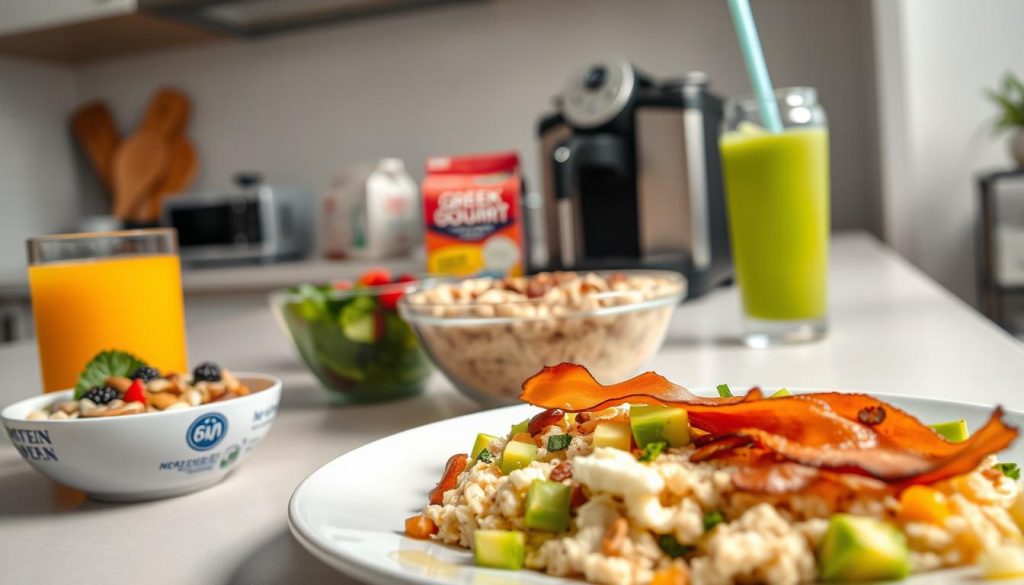I just wanted to tell you about the time I almost burned out trying to balance my meals. I’d spend hours prepping chicken breasts and protein shakes, only to feel like I’m missing something in my diet. Sound familiar? That’s why I’m sharing what I’ve learned through years of trial, error, and deep dives into nutritional science, including my top Protein Boost Tips.
Getting enough protein isn’t just about gym gains – it’s the cornerstone of energy, recovery, and long-term health. Research shows it supports everything from muscle repair to immune function. But here’s the catch: how you add it matters as much as how much you consume. These Protein Boost Tips will help you maximize your intake effectively.
Working with dietitians and testing strategies in my kitchen, I’ve discovered innovative ways to enhance meals without stripping away other nutrients. You’ll find no extreme measures here – just practical swaps and meal frameworks that work with real-life schedules.
This guide’ll walk you through my favorite methods for creating satisfying, nutrient-dense plates. We’ll explore how minor tweaks to familiar recipes can make a big difference, plus why timing and food pairing matter more than you might think. Let’s build eating habits that stick.
Understanding Why Protein Matters for Your Health
Research opened my eyes when I discovered how protein impacts every cell in my body. It’s not just about lifting weights – this nutrient acts like a multitasking repair crew. Studies show it triggers peptide YY, a hormone that keeps hunger in check while supporting muscle repair after strenuous workouts.

More Than Just Gym Gains
Here’s what surprised me: adequate intake helps white blood cells fight infections. I noticed fewer colds after prioritizing high-protein snacks like almonds and hard-boiled eggs. Scientists also link balanced consumption to better blood sugar control to prevent type diabetes.
Timing Changes Everything
Spreading 20-30 grams of protein per meal works better than loading up at dinner. My energy stays steady when I pair chicken or lentils with veggies first. This approach helps the body absorb amino acids efficiently, which is crucial for rebuilding tissues and enzymes.
What finally convinced me? Seeing how proteins stabilize my mood and focus. They’re not just building blocks – they’re biological peacekeepers. Now I plan meals around this powerhouse nutrient, knowing it supports everything from my biceps to my immune system.
Decoding Protein Requirements and Daily Goals
Many assume hitting their daily targets means endless chicken breasts. The truth? Official guidelines only tell part of the story. The Dietary Guidelines for Americans suggest 0.8 grams per kilogram of body weight – about 54g for a 150-pound person. However, studies show active individuals often need 1.2-2g/kg for optimal recovery.

Dietary Guidelines and Recommended Amounts
I use the RDA as a baseline, not a ceiling. For my 165-pound frame and regular workouts, I aim for 120g daily. Here’s how it breaks down:
- Breakfast: 30g (eggs + Greek yogurt)
- Lunch: 35g (grilled salmon + quinoa)
- Dinner: 40g (chicken thighs + lentils)
- Snacks: 15g (almonds or cottage cheese)
This protein diet prevents energy crashes and keeps muscle repair steady throughout the day.
Personalizing Your Intake Strategy
I adjust based on activity and hunger cues. I’ll add 10-15g through a post-workout shake on heavy training days. I swap white rice with edamame pasta for busy days – same carbs, triple the protein.
Tracking for a week revealed patterns. I now prep hard-boiled eggs and roasted chickpeas to hit enough protein across all meals. Remember: your needs depend on age, goals, and how your body responds. Start with 1.2g/kg and tweak from there.
5 Protein Boost Tips Without Nutrient Loss
After burning through countless meal plans, I discovered the art of strategic enhancement. It’s not about piling on more chicken – it’s about brighter combinations that lock in amino acids and vitamins.

My Kitchen-Tested Enhancement Methods
Here’s what transformed my approach:
- Layer proteins first: I build meals around lentils or eggs before adding grains – this prioritizes absorption without crowding out veggies
- Double-dip sources: Combining chickpeas with salmon provides complete amino acids while preserving iron and omega-3s
- Steam, don’t sear: Gentle cooking keeps B vitamins intact in fish and greens better than high-heat methods
- Ferment for benefits: Swapping regular yogurt for Greek adds probiotics alongside extra grams per serving
- Snack strategically: Roasted edamame satisfies crunch cravings while delivering 14g per 1/4 cup
Syncing Quality and Quantity
Balance became more manageable when I stopped viewing plant and animal sources as rivals. My go-to lunch now mixes quinoa (8g protein) with turkey breast – the grains’ fiber aids digestion while the meat’s zinc supports immunity.
Timing matters too. I eat protein-rich snacks like cottage cheese with berries when my energy dips. This steady supply prevents muscle breakdown without overloading any single meal.
Through trial and error, I learned that boosting intake works best when paired with nutrient-dense sides. Spinach wilts perfectly into lentil soup, adding iron without altering the dish’s protein focus.
Creating a High-Protein Breakfast Routine
Mornings used to leave me hangry by 10 AM until I cracked the breakfast code. Now I start with meal packing 25-30 grams of fuel – enough to power through meetings and workouts without cravings. Research confirms what I’ve lived: swapping sugary cereals for eggs or yogurt improves focus and reduces afternoon snacking by 40%.

From Cereal Bowl to Protein Powerhouse
I ditched my old routine: a typical cereal breakfast gave me 4g of protein versus 18g from two eggs. Greek yogurt adds another 17g per cup while delivering gut-friendly probiotics. My go-to combo scrambles eggs with spinach and pairs them with unsweetened yogurt topped with chia seeds.
| Breakfast Option | Protein (g) | Fiber (g) | Sugar (g) |
|---|---|---|---|
| Frosted Flakes (1 cup) | 2 | 1 | 12 |
| Scrambled Eggs (2 large) | 12 | 0 | 1 |
| Greek Yogurt (3/4 cup) | 17 | 0 | 6 |
| Protein Smoothie | 24 | 5 | 8 |
Smoothie Hacks for Rush Mornings
When time’s tight, I blend frozen berries with whey protein powder and almond milk – ready in 90 seconds. For creamier texture, I add silken tofu (10g protein per 1/2 cup). These combinations deliver sustained energy without the blood sugar rollercoaster. These are some of my favorite Protein Boost Tips!
The shift transformed my mornings: sharper mental clarity, steadier energy, and fewer impulsive snacks. Start with one swap – maybe avocado toast with a soft-boiled egg instead of jam. Your body will thank you by lunchtime.
Nutritional Benefits of Diverse Protein Sources
I used to think protein meant choosing between steak and shakes – until I discovered how variety unlocks hidden benefits. Mixing plant and animal sources transformed my meals from repetitive to revitalizing. Studies confirm combining different proteins enhances nutrient absorption while reducing chronic disease risks.
Plant Power vs. Animal Advantages
Through tracking my energy levels, I found plant proteins like lentils keep me fuller longer. A 1/2 cup delivers 9g protein plus 8g fiber – something chicken breast can’t match. But animal sources provide complete amino acids faster. My solution? Pair black beans with eggs for breakfast – the combo offers iron from plants and B12 from eggs.
| Source | Protein (g) | Key Nutrients |
|---|---|---|
| Chicken (3oz) | 26 | B12, Zinc |
| Lentils (1/2 cup) | 9 | Fiber, Folate |
| Almonds (1oz) | 6 | Vitamin E, Magnesium |
Small Seeds, Big Impact
Nuts and seeds became my secret weapons. Chia seeds add 5g of protein per tablespoon to smoothies, while walnuts boost omega-3s. I toss pumpkin seeds into oatmeal – their zinc content supports immunity better than many supplements.
Whole grains like quinoa and farro now replace white rice in my dinners. They contribute 8g of protein per cooked cup alongside manganese and antioxidants. My favorite bowl mixes grilled salmon with barley and sunflower seeds – a trifecta of texture, flavor, and sustained energy.
Diversity isn’t just healthier – it’s tastier. Blending tempeh with turkey in chili or adding hemp hearts to yogurt creates meals that satisfy both my muscles and my taste buds. This approach keeps meals exciting while covering all nutritional bases.
Smart Food Swaps for a Protein-Enriched Diet
My pantry overhaul began when I realized simple substitutions could transform ordinary meals into nutritional powerhouses. Swapping everyday staples for more brilliant alternatives helped me achieve higher protein intake without sacrificing flavor or breaking the bank.
Grain Transformations That Matter
I replaced white rice with quinoa – a single cup delivers 8g of protein versus 4g in refined grains. Whole wheat pasta became my go-to, offering 7g of protein per serving compared to regular pasta’s 5g. These changes added 10-15g of daily protein, boosting fiber intake by 40%.
| Swap | Protein Gain | Fiber Boost |
|---|---|---|
| White Rice → Quinoa | +4g per cup | +3g |
| Regular Pasta → Whole Grain | +2g per serving | +5g |
Protein-Powered Ingredient Upgrades
Ground turkey (22g protein/3oz) replaced 80% of the beef in my chili recipes, cutting saturated fat by half. Tofu became my stir-fry staple – half a block provides 20g of protein with complete amino acids. For snacks, roasted chickpeas (15g protein/cup) satisfy crunch cravings better than chips.
These strategic changes helped me:
- Save $12 weekly by using lentils instead of premium cuts
- Reduce meal prep time through batch-cooked grains
- Maintain energy levels with steady protein distribution
Now my meals naturally contain 25% more protein without extra effort. The key lies in choosing sources that pull double duty – nourishing while satisfying.
Innovative Protein Snacks That Keep Me Full
My snack drawer was a graveyard of empty calories until I discovered how strategic bites could fuel my day. Now I reach for options delivering 10-15g protein per serving – enough to bridge meals without energy crashes.
Portable Powerhouses I Always Pack
Turkey jerky became my desk staple after realizing one ounce packs 11g of protein at just 70 calories. Pairing it with almonds creates a satisfying crunch while adding healthy fats. Cottage cheese cups (14g protein) with cherry tomatoes now replace my old chips-and-salsa habit – same convenience, triple the staying power.
Here’s how my favorites stack up:
| Snack | Protein | Calories | Satisfaction |
|---|---|---|---|
| Peanut butter rice cake | 8g | 190 | ★★★★☆ |
| Greek yogurt parfait | 17g | 220 | ★★★★★ |
| Roasted edamame | 14g | 130 | ★★★☆☆ |
| Cheese stick + apple | 7g | 160 | ★★★☆☆ |
Creative Combos for Busy Days
I keep single-serve peanut butter packets everywhere – stirred into oatmeal or smeared on celery sticks. Tofu pudding (blend silken tofu with cocoa powder) became my sweet tooth solution, offering 10g of protein per half-cup. I pack roasted chickpeas seasoned with smoked paprika for road trips – they satisfy crunch cravings better than gas station chips.
These choices support my protein diet goals while aiding muscle recovery between workouts. A mid-morning yogurt bowl with walnuts keeps me focused through back-to-back meetings. The best part? Most require under two minutes prep – crucial when juggling work and training. These are my go-to Protein Boost Tips for busy days.
Start with one swap: maybe edamame instead of pretzels. Track how it affects your energy and hunger cues. Small changes here add up to significant gains in overall nutrition.
Protein-Boosting Strategies for Busy Lifestyles
Juggling client calls and meal prep taught me that efficiency matters as much as nutrition. When deadlines stack up, I rely on three core principles: prep smarter, choose cleaner sources, and leverage quick solutions that fuel my body without sugar spikes.
My 15-Minute Daily Game Plan
Sunday afternoons are for batch-cooking shredded chicken and hard-boiled eggs. These become salad toppers, wrap fillings, or stir-fry starters throughout the week. I portion Greek yogurt into jars with frozen berries – grab-and-go breakfasts with 20g of high protein content.
| Quick Source | Protein (g) | Prep Time | Fiber (g) |
|---|---|---|---|
| Pre-cooked lentils | 18 | 0 min | 15 |
| Whey isolate shake | 25 | 2 min | 0 |
| Cottage cheese cup | 14 | 0 min | 0 |
| Edamame pods | 11 | 3 min | 5 |
Shakes save me when meetings run late. My favorite blend mixes plant-based powder with almond milk and spinach – 30g protein per serving without added sugars. Using frozen veggies maintains nutrient density better than juice-based alternatives.
Snack smartly with roasted chickpeas instead of chips. They deliver 15g of protein and 12g of fiber per cup, curbing cravings better than empty carbs. I keep single-serve nut butter packets everywhere – stirred into oatmeal or paired with apple slices.
Busy people often default to processed bars loaded with hidden sugars. I compare labels rigorously, choosing options under 5g sugar and at least 10g protein. This balance prevents energy crashes while supporting muscle maintenance during hectic days.
Success lies in systems, not willpower. Dedicate one hour weekly to prep core ingredients. Store them in clear containers for visibility. These small investments make high protein choices the path of least resistance when time’s scarce.
Tailoring Protein Intake for Older Adults and Active Lifestyles
Working with clients across generations revealed a universal truth: one-size-fits-all nutrition fails aging bodies and marathon trainers. While coaching a 68-year-old triathlete and her sedentary neighbor, I learned how to calibrate protein intake for vastly different needs. The key lies in strategic adjustments that honor changing metabolisms without compromising satisfaction.
Adjusting Portions for Muscle Maintenance
I prioritize 25-30g of protein per meal for older adults to combat age-related muscle loss. A client in her 70s saw improved strength by pairing grilled chicken (28g) with quinoa instead of white rice. Active individuals often need 1.5g of protein per pound of body weight – I guide them toward lean turkey slices in whole-grain pasta dishes for sustained energy.
Meal Planning for Sustained Energy
My Sunday prep strategy for busy adults includes:
- Batch-cooked lentils mixed with roasted veggies
- Hard-boiled eggs for grab-and-go snacks
- Marinated tofu cubes are ready for stir-fries
Balancing carbs matters. I swap refined grains with wild rice or chickpea pasta – they provide steady fuel without spiking blood sugar. For those managing weight, I design plates with 40% protein, 30% complex carbs, and 30% colorful veggies to control calories naturally.
One retiree transformed her health by adding Greek yogurt to morning oatmeal – the combo delivers 22g of protein while keeping fat content low. Active clients benefit from post-workout shakes blended with spinach and almond butter, ensuring their bodies recover without unnecessary additives.
Enhancing Meal Flavor Without Nutrient Loss
I nearly ruined a week’s meal prep by overcooking salmon until lab tests showed 40% amino acid loss. I approach cooking like chemistry – precise temperatures and bright seasoning preserve taste and nutritional quality. Research confirms gentle methods retain up to 90% of essential acids compared to high-heat charring.
Using Healthy Seasonings and Cooking Methods
My spice rack became a flavor arsenal. Turmeric adds earthy notes while protecting acids during simmering. I steam fish over citrus slices for quick meals – the zesty vapor infuses without stripping nutrients. Three techniques transformed my kitchen:
- Poaching poultry in bone broth (165°F) keeps it juicy with 22g of protein per 3-oz serving
- Blanching greens preserves iron better than sautéing in high-fat oils
- Slow-roasting nuts at 250°F maintains healthy fats and vitamin E
Preserving Amino Acids Through Technique
High heat unravels protein structures. I now use sous-vide for steak – 130°F water baths keep amino chains intact. For plant-based meals, pressure-cooking lentils retains 15% more lysine than boiling. My flavor tricks:
| Method | Temp | Nutrient Retention |
|---|---|---|
| Steaming | 212°F | 92% |
| Grilling | 400°F | 68% |
| Sous-vide | 130°F | 97% |
Cutting sugar doesn’t mean blandness. Toasted cumin or smoked paprika adds depth to roasted chickpeas. I toss pumpkin seeds with nutritional yeast for umami crunch. Experiment with these swaps for one day – your taste buds and muscles will notice the difference.
Conclusion
Balancing nutrition with protein needs once felt like solving a puzzle with missing pieces. Through years of testing, I’ve found that smart food swaps and diverse sources – from lentils to Greek yogurt – create meals that fuel both body and mind. The strategies we’ve explored prove that enhancing your diet doesn’t require drastic overhauls, just intentional choices.
Prioritizing plant-based proteins alongside lean meats ensures you get essential acids without excess sugar or processed grains. Whether upgrading breakfast with chia seeds or choosing edamame over chips, small shifts yield lasting benefits for weight management and energy levels.
Remember: your ideal intake depends on activity, age, and goals. A retiree might thrive on 25g per meal of fish and quinoa, while a busy parent benefits from portable snacks like roasted chickpeas. Start with one change – maybe swapping white rice for farro – and track how your body responds.
True nutritional quality comes from consistency, not perfection. Keep experimenting with spices, cooking methods, and protein pairings. Your plate should celebrate flavor as much as function. Ready to feel the difference? Begin tomorrow’s breakfast with a protein-rich smoothie and notice the sustained focus it brings. That’s the power of a diet built to last.
